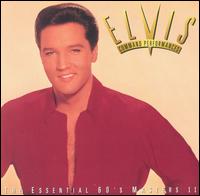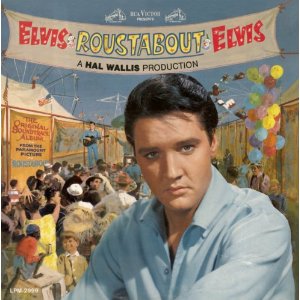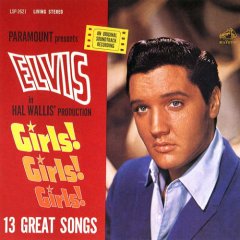
His Hand in Mine is the fifth studio album by American singer and musician Elvis Presley, released on RCA Victor Records in mono and stereo, LPM/LSP 2328, in November 1960. It was the first of three gospel music albums that Presley would issue during his lifetime. Recording sessions took place on October 30 and 31, 1960, at RCA Studio B in Nashville, Tennessee. It peaked at #13 on the Top Pop Albums chart. It was certified Gold on April 9, 1969 and Platinum on March 27, 1992 by the Recording Industry Association of America.

Elvis for Everyone! is the eighth studio album by American singer and musician Elvis Presley, issued by RCA Victor in mono and stereo, LPM/LSP 3450, in August 1965. Recording sessions took place over a ten-year span at Sun Studio in Memphis, RCA Studio B in Nashville, Tennessee, and Radio Recorders in Hollywood, California. It peaked at number 10 on the Top Pop Albums chart.

Elvis' Gold Records Volume 4 is a greatest hits album by American rock and roll singer Elvis Presley, issued by RCA Victor in mono and stereo, LPM/LSP 3921, in January 1968, with recording sessions taking place over an eight-year span at RCA Studio B in Nashville, Tennessee, and at RCA Studios and Radio Recorders in Hollywood. It is a compilation of hit singles released between 1961 and 1967, peaking at number 33 on the Billboard 200. It was certified Gold on March 27, 1992 by the Recording Industry Association of America.

From Nashville to Memphis: The Essential '60s Masters is a five-disc box set compilation of studio master recordings by American singer and musician Elvis Presley during the decade of the 1960s; it was released in 1993 on RCA Records, catalogue number 66160-2. In its initial long-box release, it included a set of collectable stamps duplicating the record jackets of every Presley LP on RCA Victor, and those of the singles pertinent to this box set. The set also includes a booklet with an extensive session list and discography, as well as a lengthy essay by Peter Guralnick. It was certified Gold by the RIAA on November 30, 1993, and Platinum on January 6, 2004. This set followed an exhaustive box set of Presley's 1950s output and was followed by a more selective box set of his work in the 1970s.

Command Performances: The Essential 60s Masters II is a two-disc compilation of studio master recordings by American singer and musician Elvis Presley during the decade of the 1960s, released in 1995 on RCA Records, catalogue number 66601-2. It also includes a booklet with session details and an essay by Susan M. Doll.

Double Trouble is the fifteenth soundtrack album by American singer and musician Elvis Presley, released by RCA Victor in mono and stereo, LPM/LSP 3787, in June 1967. It is the soundtrack to the 1967 film of the same name starring Presley. Recording sessions took place at Radio Recorders and at Metro-Goldwyn-Mayer studios in Hollywood, California, on June 28, 29, and 30, 1966. It peaked at number 47 on the Billboard 200.

Roustabout is the ninth soundtrack album by American singer and musician Elvis Presley, released on RCA Victor Records in mono and stereo, LPM/LSP 2999, in October 1964. It is the soundtrack to the 1964 film of the same name starring Presley. Recording sessions took place at Radio Recorders in Hollywood, California, on March 2 and 3, and April 29, 1964. It peaked at number one on the Billboard Top LP's chart. It was certified Gold on May 20, 1988 by the Recording Industry Association of America. The album would be Presley's final soundtrack to reach number one and his last number one album until 1973's Aloha From Hawaii: Via Satellite.

Girls! Girls! Girls! is the fifth soundtrack album by American singer and musician Elvis Presley, released on RCA Victor Records in mono and stereo, LPM/LSP 2426, in November 1962. It accompanied the 1962 film of the same name starring Presley. Recording sessions took place at Radio Recorders in Hollywood on March 26, 27, and 28, 1962. It peaked at number three on the Top LP's chart. It was certified Gold on August 13, 1963 by the Recording Industry Association of America.

Kissin' Cousins is the eighth soundtrack album by American singer and musician Elvis Presley, released by RCA Victor in mono and stereo, LPM/LSP 2894, in April 1964. It is the soundtrack to the 1964 film of the same name starring Presley. Recording sessions took place at RCA Studio B in Nashville, Tennessee, on May 26 and 27, and September 29 and 30, 1963. It peaked at number six on the Billboard Top LP's chart. The album was certified Gold on March 27, 1992 by the Recording Industry Association of America.

Harum Scarum is the eleventh soundtrack album by American singer and musician Elvis Presley, released by RCA Victor in mono and stereo, LPM/LSP 3468, in November 1965. It is the soundtrack to the 1965 film of the same name starring Presley. Recording sessions took place at RCA Studio B in Nashville, Tennessee, on February 24, 25, and 26, 1965. It peaked at number eight on the Top LP's chart.

Frankie and Johnny is the twelfth soundtrack album by American singer and musician Elvis Presley, released on RCA Victor Records in mono and stereo, LPM/LSP 3553, on March 1, 1966. It is the soundtrack to the 1966 film of the same name starring Presley. Recording sessions took place at Radio Recorders in Hollywood, California, on May 12, 13, and 14, 1965. It peaked at number 20 on the Top LP's chart. It was certified Gold and Platinum on January 6, 2004 by the Recording Industry Association of America.

Spinout is the fourteenth soundtrack album by American singer and musician Elvis Presley, released by RCA Victor in mono and stereo, LPM/LSP 3702, on October 31, 1966. It is the soundtrack to the 1966 film of the same name starring Presley. Recording sessions took place at Radio Recorders in Hollywood, California, on February 16 and 17, 1966. It peaked at number 18 on the Top Pop Albums chart.

Clambake is the sixteenth soundtrack album by American singer and musician Elvis Presley, released by RCA Victor in mono and stereo, LPM/LSP 3893, in October 1967. It is the soundtrack to the 1967 film of the same name starring Presley. He entered RCA Studio B in Nashville, Tennessee on February 21, 1967 for Recording sessions for his twenty fifth film. Supplemental material sessions took place on September 10 and 11, 1967. It peaked at number 40 on the Billboard 200.

We're Gonna Move is a song by Elvis Presley. The song is credited to Elvis Presley and Vera Matson, the wife of Ken Darby, the principal writer, published by Elvis Presley Music. The song was featured in the movie Love Me Tender and was released as an RCA Victor EP in 1956.
Let Me is a song by Elvis Presley. The song is credited to Elvis Presley and Vera Matson, the wife of Ken Darby, the principal writer, published by Elvis Presley Music. The song was featured in the movie Love Me Tender and was released as an RCA Victor EP in 1956.
Poor Boy is a song by Elvis Presley. The song is credited to Elvis Presley and Vera Matson, the wife of Ken Darby, the principal writer, published by Elvis Presley Music. The song was featured in the movie Love Me Tender and was released as an RCA Victor EP in 1956.

Easy Come, Easy Go is an EP by American singer Elvis Presley, containing songs from the motion picture of the same name, released by RCA Victor in March 1967.

Love Me Tender is an EP by Elvis Presley, containing the four songs from the motion picture of the same name. It was released by RCA in November 1956. The EP peaked at #9 on Top Pop Albums chart with sales of over 600,000, as well as making it to #35 on the singles chart. It was simultaneously certified Gold and Platinum by the Recording Industry Association of America on March 27, 1992.

Tickle Me Vol. 1 and Tickle Me Vol. 2 are two extended plays by Elvis Presley, containing songs from the motion picture of the same name. They were released by RCA Victor in 1965.
"Fun in Acapulco" is a song written by Ben Weisman and Sid Wayneand first recorded by Elvis Presley as part of the soundtrack for his 1963 motion picture Fun in Acapulco. It was released on the eponymous soundtrack album in 1963.




























